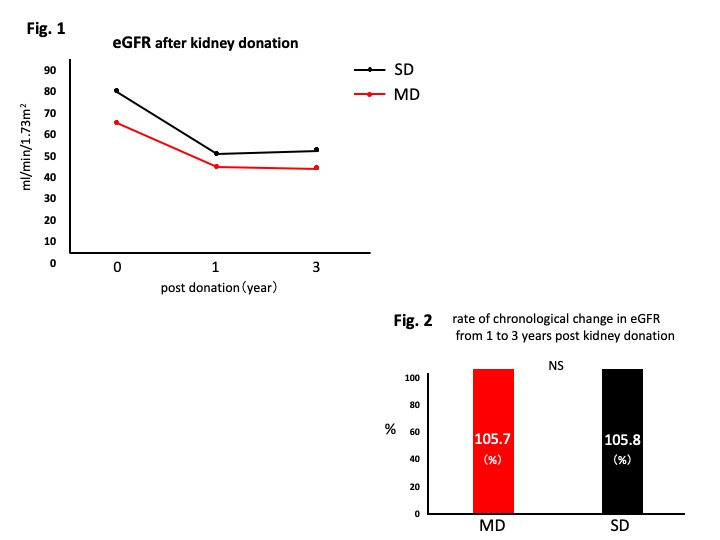Evaluation of Renal Function After Donation in Living Marginal Kidney Donor
1Urology, Sapporo City General Hospital, Sapporo, Japan, 2Kidney Transplant Surgery, Sapporo City General Hospital, Sapporo, Japan
Meeting: 2022 American Transplant Congress
Abstract number: 1719
Keywords: Donors, marginal, Kidney transplantation, Living donor
Topic: Clinical Science » Kidney » 42 - Kidney Living Donor: Selection
Session Information
Session Name: Kidney Living Donor: Selection
Session Type: Poster Abstract
Date: Tuesday, June 7, 2022
Session Time: 7:00pm-8:00pm
 Presentation Time: 7:00pm-8:00pm
Presentation Time: 7:00pm-8:00pm
Location: Hynes Halls C & D
*Purpose: Chronic kidney-donor shortage is major concern in Japan where more than 90% of recipients received kidneys from living donor as kidney transplantation from deceased donors occurs less. Therefore, living kidney transplantation from marginal donor (MD) is an important solution for such a problem. We evaluated the renal function and its chronological change in MD post donation to validate the adequacy of marginal donor criteria.
*Methods: Enrolled patients were 101 donors who donated their kidney at our hospital from 2014 to 2016. MD was defined as those with 70 years older, low GFR (total GFR: 70-80ml/min/1.73m2), high body mass index (BMI: 25kg/m2<), hypertension and diabetes with hemoglobin A1c >6.2%. Among 101, 25 donors (24.7%) met with marginal donor criteria. (MD group) Control group consisted of 76 patients who met standard criteria donor (SD group). The renal function after kidney donation was compared between the two groups.
*Results: MD group composed of 8 elderly patients, 9 patients with low GFR, 2 patients with high BMI, 12 patients with hypertension and 2 with diabetes mellitus (including duplicate cases). There was no difference in age at donation and sex between the two groups. The median eGFR (ml /min/1.73m2) at 1 and 3 years after kidney donation was 45.0 and 44.3 in the MD group and 51.2 and 52.9 in the SD group, which were significantly lower in the MD group. (Fig.1) On the other hand, rate of chronological change in eGFR (%) from 1 to 3 years post kidney donation was 105.7 in the MD group and 105.8 in the SD group, which indicating no difference between the two groups. (Fig.2) No cases leading to end-stage renal disease were found in either group.
*Conclusions: MD was inferior to SD in residual renal function, but did not show deterioration of renal function over time after kidney.Although indications for marginal criteria donor are valid in the short term, longer follow-up is required.
To cite this abstract in AMA style:
Harada S, Sasaki H, Takada Y, Takamoto D, Hirano T, Kan T, Yamagata Y, Harada H, Minami K, Moriya K, Tanaka H. Evaluation of Renal Function After Donation in Living Marginal Kidney Donor [abstract]. Am J Transplant. 2022; 22 (suppl 3). https://atcmeetingabstracts.com/abstract/evaluation-of-renal-function-after-donation-in-living-marginal-kidney-donor/. Accessed December 28, 2025.« Back to 2022 American Transplant Congress

